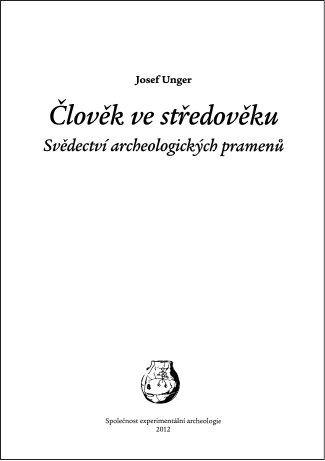
Volume IV ● Issue 1/2013 ● Page 113
Book Reviews
Unger, Josef: People in the Middle Ages. A Testimony of Archaeological Sources. Edition popularization of archaeology. Society of Experimental Archaeology 2012, 64 p., 113 illustrations.
The work is based on a no longer in print publication from 2008 “Archaeology of the Middle Ages. A reflection on life in archaeological sources.”, published by University of Hradec Kralové. This publication from 2012 is complemented with a burial rite and new information in order to correspond with the current state of knowledge. The purpose of the publication is to contribute to a deeper understanding of the life of people in the Middle Ages, on the basis of archaeological sources in the concept of archaeological anthropology.
The introductory chapters and subchapters briefly outline the main working methodology, the basic literature on the topic, the periodization of the Middle Ages and the geographical, natural and historical framework. From the perspective of history, the work briefly and concisely explains the beginnings of Slavic settlement, the Great Moravian Empire, the beginnings of the Czech state and the Czech state at the time of the Premyslid and Luxembourg kings. The work is focused on the Czech Republic and to the largest extent on Moravia.
The chapter “People in the Middle Ages” is the most important part of the work and has 14 subchapters, which focus on archaeological sources which illuminate the lives of farmers, artisans, miners, metallurgists, builders of hill forts and castles, urban residents, clergy, students and teachers, princes and rulers, soldiers in war, the Moravian Brethren and Jews.
The first subchapter “Farmers” deals with the lives of the largest components of medieval society from the 6th century to the early modern period. In this context it also makes mention of selected important sites from the Czech Republic, such as housing estates (Březno u Loun, Roztoky, Mutěnice, Sady u Uherského Hradiště, Palonín, Mstěnice u Hrotovic), burial grounds (Morkůvky, Diváky, Divice) and villages (Mstěnice, Pffafenschlag, Konůvky, Bystřec, Svídna, Topolany, Želice, Nyrvice, Koválov, Chroustov).
Another subchapter focuses on the lives of artisans. It describes blacksmiths and jewelers (Mikulčice-Valy, Staré Město u Uherského Hradiště), bakers (Soběslav) and potters (Loštice). A significant part is dedicated to the area of Sezimovo Ústí where several handicraft industries (blacksmithing, pottery, malting, brickmaking) were merged.
In the following subchapter the reader gains an acquaintance with the formation, function, form of cities and its inhabitants. This medieval arrangement is presented with examples from selected sites (Břeclav-Pohansko, Hradišťko u Davle, Radkov, Děčín, Most, Sezimovo Ústí).
The next part of the publication deals with the higher social environment where numerous significant changes came about over the period from the 6th to the 15th centuries. Various localities where higher social groups lived are presented. This includes descriptions of the kinds of localities such as fortress (Bedřichův Světec, Čimice, Mstěnice, Konůvky, Rýmařov, Lelekovice), fortress of the “motte” type (Koválov) and castles (Rokštejn, Lelekovice, Sion). A uniquely preserved Manx house is also mentioned here. The archaeological research yielded important insights into the life of the gentry which was tied to Křivoklát castle through their duties.
Another subchapter the “Sovereigns” deals with the ruling class of medieval society. In Moravia it is focused primarily on the Great Moravian centre Mikulčice and in Bohemia on Prague Castle. Additional localities such as the Břeclav-Pohansko court and Hradec u Nemětic hill fort are also mentioned.
The chapter entitled “Soldiers at war”, which describes the specific way of life of the military component is of particular interest. It deals with castles (Lelekovice), camps (Šumice, Smolín u Sezimova Ústí), siege fortifications (Nový Hrad u Adamova, Lopata) and also with the former Cartesian monastery in Dolany which was sacked by the Hussites.
Several chapters are devoted to issues of faith, where Jews (Prague) and the Moravian Brethren (Ivančice, Kralice nad Oslavou) are mentioned amongst others. The primary group is of course parochial and monastic clergy, who were connected with the locations Uherské Hradiště-Sady, the Benedictine monastery in Sázava, the Cistercian monastery in Velehrad and the Carthusian monastery in Dolany.
The entire work is complemented by visual material placed in the text. This includes drawing documentation, reconstruction drawings and photographs of sites and artefacts. The glossary, bibliography and a brief description of the author are attached to the end of the book. The publication “People in the Middle Ages” is brief but extremely concise. It provides systematic and logically organised insight into all the social groups of medieval society and their lives.
Veronika Hanušová
